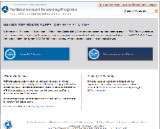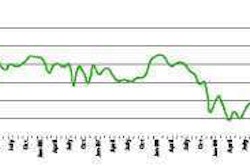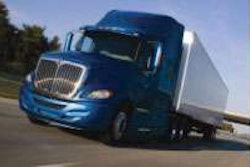EPA, NHTSA to issue heavy truck mpg rule
New standards ordered by July 2011
President Obama last month signed a presidential memorandum directing the U.S. Department of Transportation’s National Highway Traffic Safety Administration and the U.S. Environmental Protection Agency to jointly issue the nation’s first fuel economy and greenhouse gas emissions standards on new medium- and heavy-duty trucks, beginning with model year 2014. The president directed that EPA and NHTSA try to issue a final rule by July 30, 2011. The announcement came at a White House signing ceremony that involved the senior executives of the major truck and engine manufacturers and other leaders, including American Trucking Associations Chairman Tommy Hodges. (See Fuel Savvy.)

The standards should take into account “the market structure of the trucking industry and the unique demands of heavy-duty vehicle applications,” the memorandum states. They also should seek harmonization with applicable state standards, consider the findings and recommendations in the National Academy of Science report “and enhance job creation in the United States,” it adds.
Standards are to stress existing technologies.
In 2007, Congress directed DOT to issue fuel economy standards on medium- and heavy-duty trucks following a National Academy of Sciences study. The National Research Council, the parent organization of NAS, issued that report on March 31. Under the 2007 law, the standards were to come by the middle of this decade, which the presidential memorandum would accomplish.
Obama directed EPA and NHTSA to “seek input from all stakeholders, while recognizing the continued leadership role of California and other States.”
The announcement comes exactly one year after the Obama administration announced an agreement to increase fuel efficiency for cars and light trucks. In his comments, Obama said that medium- and heavy-duty vehicles account for about one-fifth of all greenhouse gas emissions.
As with the automobile standards announced earlier, the Obama administration has expanded the scope of the regulations to include not only fuel efficiency but greenhouse gas emissions, which is why EPA and NHTSA issued the new car and light-truck standards jointly earlier this year. While fuel use and greenhouse gas emissions are linked closely, there are automotive functions – such as gases used in air conditioning – that affect greenhouse gases without necessarily affecting fuel economy.
In brief
* The American Transportation Research Institute concluded that trucking safety has improved since 2004 when the Federal Motor Carrier Safety Administration’s first major rewrite of the hours-of-service rules took effect. ATRI’s analysis of data from about 260 motor carriers representing 127,000 commercial drivers showed that the total collision rate dropped 11.7 percent from 2004 to 2009, while preventable collisions declined 30.6 percent. To view ATRI’s report, go to www.atri-online.org/ATRI_HOS_Analysis_2010.pdf.
* According to the “ATA U.S. Freight Transportation Forecast to 2021” released by the American Trucking Associations, total freight tonnage is projected to grow 25 percent by 2021, and total freight transportation revenue will grow 69 percent. The report can be purchased at www.atabusinesssolutions.com.
* Rick Foster, director of private fleet safety for Wal-Mart Transportation, was appointed chair of the National Private Truck Council at the group’s 2010 Annual Education Management Conference and Exhibition in Cincinnati.
* The American Trucking Associations is seeking nominations for the fourth annual Mike Russell “Good stuff” Trucking Image Award that honors those that creatively generate positive awareness of the trucking industry. For a nomination form, go to TrucksBringIt.com. The deadline is Sept. 3.
* The U.S. Department of Transportation’s Bureau of Transportation Statistics released “Freight Transportation: Global Highlights 2010,” a snapshot of freight transportation activity from a global perspective. The report can be found at www.bts.gov/publications/freight_transportation.
UCR fees nearly double
The Federal Motor Carrier Safety Administration issued a final rule effective immediately on annual registration fees and a fee bracket structure for the Unified Carrier Registration (UCR) Agreement for the calendar year beginning Jan. 1, 2010. The minimum fee, which applies to a one-truck operation or to a broker or freight forwarder, increased from $39 to $76, while the maximum fee for for-hire and private carriers with more than 1,000 trucks rose from $37,500 to $73,346. The 2010 fees are: 0-2 CMVs, $76; 3-5 CMVs, $227; 6-20 CMVs, $452; 21-100 CMVs, $1,576; 101-1,000 CMVs, $7,511; and 1,001 and above, $73,346.
The agency said several factors drove the need to increase fees in order to provide the $113 million necessary to provide states with the revenues they received under the Single State Registration System. One was a change in federal law in 2008 that eliminated trailers from the calculation; that change alone required an increase in fees to maintain the revenue even if every single carrier complied, FMCSA said.
Compliance with the registration requirement has been far from 100 percent. Between 80 and 90 percent of carriers operating 100 or more trucks have registered under UCR, but the compliance rate among brokers and freight forwarders is only 16 percent, and fewer than 60 percent of single-truck operations have registered; in 2008, the overall compliance rate was 62.5 percent. While industry representatives on the UCR board believed the fees should continue to be based on 100 percent compliance, FMCSA chose a compliance rate of about 86 percent. And on top of those concerns was a phenomenon FMCSA called “bracket shift,” where carriers ended up registering fewer trucks than anticipated.
The Truckload Carriers Association opposed the proposal because it would “negatively affect the motor carrier industry in order to subsidize both noncompliant motor carriers and the states that will not put forth the effort to increase UCRA [UCR Agreement] compliance.’’ The Transportation Intermediaries Association called FMCSA’s analysis flawed. The American Trucking Associations and TIA both faulted the NPRM for giving an impression of “illusory precision,’’ arguing that “the unwarranted show of accuracy covers much guesswork and some arbitrary assumptions.’’
To view the final rule and comments, go to
www.regulations.gov. The docket is FMCSA-2009-0231.
Trucking employment up slightly in April
 PAYROLL EMPLOYMENT IN FOR-HIRE TRUCKING Trucking companies added 1,000 jobs in April, but trucking employment was still down 47,700, or 3.7 percent, from April 2009, according to preliminary figures released last month by the U.S. Department of Labor’s Bureau of Labor Statistics.
PAYROLL EMPLOYMENT IN FOR-HIRE TRUCKING Trucking companies added 1,000 jobs in April, but trucking employment was still down 47,700, or 3.7 percent, from April 2009, according to preliminary figures released last month by the U.S. Department of Labor’s Bureau of Labor Statistics.Trucking companies added 1,000 jobs in April, but payroll employment for the industry was 3,200 lower than what the government reported initially for March. Preliminary figures released by the U.S. Department of Labor’s Bureau of Labor Statistics showed that the for-hire trucking industry added 1,000 jobs in April over March, but the latest figures also revised downward the payroll employment numbers for February and March. The 600-job increase BLS initially reported for March became a 2,400-job loss, and that was on top of a 1,200-job downward revision for February that also was included in the figures BLS released last month.
Trucking employment in April was down 47,700, or 3.7 percent, from April 2009. Preliminary data showed payroll employment of almost 1.227 million jobs – down 226,700, or 15.6 percent, from the trucking employment peak in January 2007. The BLS numbers reflect all payroll employment in for-hire trucking, but they don’t include trucking-related jobs in other industries, such as a truck driver for a private fleet.
Within the broad category of transportation and warehousing, employment was down 20,000 due to a 21,000-job reduction in the courier and messenger industry.
Nationwide, the economy gained 290,000 jobs in April, according to preliminary BLS numbers; a large portion of that increase resulted from the hiring of 66,000 temporary workers to conduct the Census.
FMCSA’s Pre-Employment Screening Program now live
The Federal Motor Carrier Safety Administration began its Pre-Employment Screening Program last month, allowing carriers the option of accessing driver inspection and crash records before hiring. The PSP provides up to five years of driver crash data and three years of inspection information. Program data is provided monthly by FMCSA’s Motor Carrier Management Information System, which is comprised of driver performance data such as inspection and compliance review results, enforcement data, state-reported crashes and carrier census data.
William Quade, of the agency’s Enforcement and Program Delivery, described the PSP in a memorandum as “essentially the public access version of the Driver Information Resource that has been available to FMCSA division offices and state enforcement partners for several years.”
 The Federal Motor Carrier Safety Administration’s Pre-Employment Screening Program allows carriers the option of accessing driver inspection and crash records before hiring.
The Federal Motor Carrier Safety Administration’s Pre-Employment Screening Program allows carriers the option of accessing driver inspection and crash records before hiring.FMCSA contracted with National Information Consortium Technologies (NIC Technologies) to provide data electronically to carriers with the drivers’ written consent. The carrier must enroll to participate in this optional program, and driver records are protected under federal privacy laws.
Drivers may purchase their own Driver Information Resource record for $10 and are not charged a subscription fee. The system provides drivers opportunities to verify their data and correct discrepancies. Drivers may obtain their own information free from FMCSA by submitting a Privacy Act request.
Carriers are charged $10 for each driver’s history and an annual subscription fee of $100. Carriers with fewer than 100 power units qualify for a discounted annual fee of $25 per year.
More information is available at www.psp.fmcsa.dot.gov.
Industry seeks changes in EOBR specs
Leading suppliers of electronic onboard recorder (EOBR) technology and groups representing trucking companies, private fleets, bus operations and law enforcement agencies asked for two changes in the performance specs that will be required for EOBRs in two years. The Federal Motor Carrier Safety Administration’s final EOBR rule “includes two technical specifications that are unrealistic, very costly and are probably not what was actually intended,” the carrier groups and technology providers said in a joint petition for reconsideration.
The technical specs targeted by carriers and vendors are the requirements that an EOBR be able to operate in temperatures ranging from -40 to 85 degrees Celsius and be capable of transferring records-of-duty status using a USB Type B connector and implementing the Mass Storage class (08h) for driverless operation. These specifications “would force the industry to develop significantly more expensive hardware and to incur extraordinary transitional costs in order to be compliant,” the petition states.
The operating temperature range is not supported currently by commercially available ruggedized mobile computing systems or any EOBR in use today, the petition states; commercially available ruggedized telematics devices with displays typically meet a minimum operating temperature range of -20 to 60 degrees C. The petitioners recommended that FMCSA either drop the operating temperature range requirement altogether or adopt the range currently met by commercially available ruggedized devices.
On the USB connection issue, the petitioners pointed out that most EOBR-capable devices with a USB interface support Type A connectors, not Type B. In addition, those devices may have processors and file systems with limitations in supporting emulation of a USB mass storage device. If the specification allowed for EOBRs to have a Type A connector and the download process to use a USB mass storage device provided by the enforcement agent, existing devices would be compatible immediately, the petitioners said.
The organizations submitting the petition for reconsideration were Qualcomm, PeopleNet, Xata, Continental Corp., American Trucking Associations, American Bus Association, Commercial Vehicle Safety Alliance, National Private Truck Council and United Motorcoach Association.
– Avery Vise
ATA pushes for modified sleeper berth provision
Current federal hours-of-service rules have played a role in improving highway safety, but the Federal Motor Carrier Safety Administration should modify the sleeper berth provision to allow for additional flexibility to further improve driver alertness, the American Trucking Associations said April 21 in comments submitted to FMCSA. ATA’s comments were in response to questions posed during the five public listening sessions held across the country as FMCSA again considers HOS changes requested by special interest groups.
 ATA says FMCSA should modify the sleeper berth provision to allow for additional flexibility to further improve driver alertness.
ATA says FMCSA should modify the sleeper berth provision to allow for additional flexibility to further improve driver alertness.Extensive federal data shows that trucking industry safety performance has improved substantially since 2004, when the basic framework for the current HOS regulations took effect. The most recent figures from the U.S. Department of Transportation indicate that the truck-involved fatality rate declined 12.3 percent in 2008 to 1.86 per 100 million miles, from 2.12 per 100 million miles in 2007. This decline marks the largest year-to-year drop ever and the fifth consecutive year the fatality rate has dropped.
Persons injured in large truck crashes went from 44.4 per 100 million miles to 39.6, an 11 percent reduction. Since 2004, the number of large truck crash injuries per 100 million miles has dropped 25 percent, and the truck-involved fatality rate has dropped 22 percent. The fatality rate has dropped 66 percent since DOT began keeping those records in 1975 and is now at its historical low.
ATA says that FMCSA, to better address the true causes of fatigue in transportation, should focus its resources on sleep disorder awareness, training and screening; promoting the use of fatigue risk management programs; evaluating the use of fatigue detection devices; increasing the availability of truck parking on important freight corridors, and partnering with the trucking and shipping communities to develop an educational process that identifies for drivers the location of available truck parking. n











